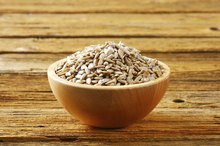20 Percent Kidney Function
Patients whose kidney function has dropped to a mere 20 percent are likely to be facing renal failure soon 5. At this stage of renal disease, it becomes a life and death matter for patients to take good care of themselves. Often that means disregarding the well-meaning but inappropriate advice from family and friends who just don't know much about kidney disease. Patients should instead follow the advice of their nephrologist.
Potassium
Many patients who only have 20 percent function have problems with excess potassium because their kidneys no longer remove excess potassium from the blood. The Merck Manual explains that excess potassium can be life-threatening because potassium is involved in nervous conduction. If levels are too high, heart arrhythmias can occur.
Nephrologists routinely monitor potassium. Potassium levels are controlled through dietary restriction. Many otherwise healthy foods, such as bananas, oranges and milk have high levels of potassium. Patients should use a potassium counter such as the one issued by the USDA and plan their meals accordingly.
- Many patients who only have 20 percent function have problems with excess potassium because their kidneys no longer remove excess potassium from the blood.
- The Merck Manual explains that excess potassium can be life-threatening because potassium is involved in nervous conduction.
Anemia
Heart-Healthy Food Choices for Chronic Kidney Disease (CKD) Patients
Learn More
Many folks with 20 percent function begin to experience overwhelming fatigue and breathlessness, often caused by anemia. The National Institutes of Health explains that healthy kidneys secrete a hormone called erythropoietin, which is responsible for the maturation of red blood cells. Since scarred kidneys are less capable of secreting this hormone, patients with advanced kidney disease have a high population of immature cells called erythrocytes and a low population of mature red blood cells. While this type of anemia cannot be treated by eating high iron foods, it can be treated by injections of synthetic EPO.
- Many folks with 20 percent function begin to experience overwhelming fatigue and breathlessness, often caused by anemia.
- Since scarred kidneys are less capable of secreting this hormone, patients with advanced kidney disease have a high population of immature cells called erythrocytes and a low population of mature red blood cells.
Phosphorus
Many people with 20 percent function experience itchy skin. This is caused by excess phosphorus. Just as the kidneys lose their ability to filter potassium, they also lose their ability to filter phosphorus. Dietary restriction is very helpful in minimizing this symptom. A good skin moisturizer can help sooth skin after it has been scratched.
- Many people with 20 percent function experience itchy skin.
- A good skin moisturizer can help sooth skin after it has been scratched.
Future Plans
Can Low Potassium Cause Death?
Learn More
While patients may have several years before undergoing transplant or dialysis, kidney function can decline rapidly once kidney function drops to 20 percent. Drugs such as ibuprofen that are otherwise innocuous in healthy people can cause a perilous drop in function, as can simple illnesses such as a head cold. Patients should start being prepared for the eventuality of kidney failure so they are not caught off guard 5.
Transplant
Patients with 20 percent kidney function may want to start thinking about prospective kidney donors. They should not rely on a single donor, because that donor may not be a good match or may be excluded from donating because of hypertension or other health issues. Patients should ask their nephrologist when potential donors should begin the screening process, because it can take several months, and should also ask if paired donations are feasible. A paired donation allows a donor to donate to someone else in exchange for a kidney for a patient. As of 2010, these are uncommon, but several facilities, such as Johns Hopkins, help make arrangements for paired donations.
- Patients with 20 percent kidney function may want to start thinking about prospective kidney donors.
- Patients should ask their nephrologist when potential donors should begin the screening process, because it can take several months, and should also ask if paired donations are feasible.
Dialysis
Even if a patient has a donor lined up, it is appropriate to start researching what modality of dialysis would work best with his lifestyle. The two types of dialysis are hemodialysis and peritoneal dialysis. Patients who choose HD go to a dialysis facility three times a week, where their blood is cleaned. Patients who choose PD dialyze themselves using a catheter in their belly. Both types of dialysis have advantages and risks.
- Even if a patient has a donor lined up, it is appropriate to start researching what modality of dialysis would work best with his lifestyle.
Related Articles
References
- National Institutes of Diabetes, Digestive and Kidney Disease: Transplantation
- National Institutes of Diabetes, Digestive and Kidney Diseases: Anemia in Kidney Disease and Dialysis
- MedlinePlus: Hyperkalemia
- Merck Manual: Chronic Kidney Failure
- Cleveland Clinic. Kidney Failure. Last Reviewed January 10, 2018.
- Potpara TS, Jokic V, Dagres N, et al. Cardiac Arrhythmias in Patients with Chronic Kidney Disease: Implications of Renal Failure for Antiarrhythmic Drug Therapy. Curr Med Chem. 2016;23(19):2070-83. doi:10.1093/eurheartj/ehy060
- Centers for Disease Control. National Chronic Kidney Disease Fact Sheet. 2017. Published 2017.
- Kazancioğlu R. Risk factors for chronic kidney disease: an update. Kidney Int Suppl (2011). 2013;3(4):368-371. doi:10.1038/kisup.2013.79
- National Institute of Diabetes and Digestive and Kidney Diseases. Choosing a Treatment for Kidney Failure. Published January 2018.
- Kim, D., Kim, M, Kim, H. et al. Early Referral to a Nephrologist Improved Patient Survival: Prospective Cohort Study for End-Stage Renal Disease in Korea. PLoS One. 2013. 8(1):e55323.
- Smart, N., and T. Titus. Outcomes of Early versus Late Nephrology Referral in Chronic Kidney Disease: A Systematic Review. American Journal of Medicine. 2011. 124(11):1073-80.e2.
- Smart, N., Dieberg, G., Ladhani, M., and T. Titus. Early Referral to Specialist Nephrology Services for Preventing Progression to End-Stage Kidney Disease. Cochrane Database for Systematic Reviews. 2014. (6):CD007333.
Resources
Writer Bio
Shelly Morgan has been writing and editing for over 25 years for various medical and scientific publications. Although she began her professional career in pharmacological research, Morgan turned to patent law where she specialized in prosecuting patents for medical devices. She also writes about renal disease and hypertension for several nonprofits aimed at educating and supporting kidney patients.









